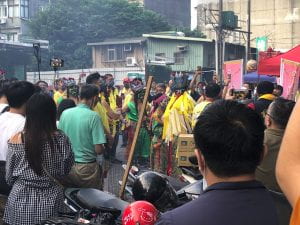Within Taipei’s Wanhua (Monga) district, a centuries-old celebration lasts annually from November 13th to November 15th (October 20th-22nd in the lunar calendar). The residents celebrate the birthday of the Qingshan King, a local deity responsible for warding off disease and serving justice.
Starting the procession was a speech summarizing the history of the Qingshan King and his role as a god. Lanterns hung on telephone poles as everyone prepared to begin an eight-hour march through all temples. Music was blaring around the festival, and street vendors gathered to sell sausages, corn on the cob, and other snacks.

Preparations for the festival on Guiyang Street
As the festivals began, multiple people followed the Qingshan King’s journey through the streets of Wanhua District. Guarding him are the Eight Generals (八家將) of the underworld. Sporting fangs and facepaint, these bodyguards ward off ghosts and evil spirits to keep the Qingshan king safe. Little yellow pieces of paper dangle off the back of their hats that people can pick up if they fall off. Some even use tigers to force mischievous kids to behave.

Some of the Eight Generals
In addition to the Eight Generals, devotees to the king lit multiple firecrackers to ward off more evil spirits. These firecrackers commonly light up in areas known for incidents such as car accidents or crimes. Be sure to cover your ears and nose when the firecrackers are lit because the explosions result in thunderous noises and heavy smoke.

Smoke from the fireworks
After some time, trucks drove with the procession handing out traditional bread rolls called kompia (光餅). These pieces of bread look similar to bagels but are much smaller. After taking the kompia, I went into the main Qingshan Temple, where I lit 5 sticks of incense, hoped for good fortune, prayed, and placed one stick in a bowl. Nearby were smaller temples filled with offerings from followers and statues of the Qingshan King and other gods.

A piece of Kompia

A bowl of burnt incense sticks

A smaller temple dedicated to the Qingshan King.
Finally, I looped around the temple holding the other incense sticks and went into another room where a statue of the Qingshan king surrounded other gods and figures from Buddhist and Daoist lore. After placing the rest of the sticks inside another bowl, I washed my hands and left. When I left, the festival continued for hours, the convoy passing each temple until nightfall. To get a glimpse of the entire festival, here is a video from last year

The temple room where the Qingshan King surrounds other deities and figures.

Messages encouraging people to contribute to the Qingshan festival






































